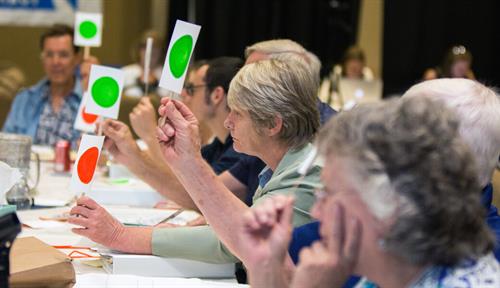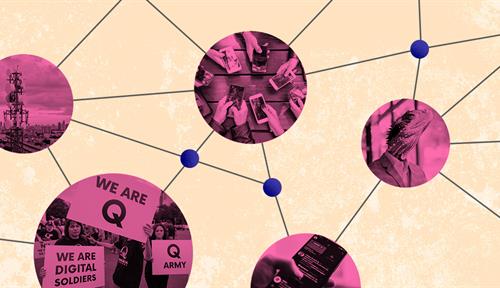Divided we stand: The rise of political animosity
Scientists peered into the partisan abyss. Here’s what they found.
Support sound science and smart stories
Help us make scientific knowledge accessible to all
Donate today
America, it is often said, has never been more divided. Gone are the days when politicians routinely brokered deals across the aisle, and Republican and Democratic voters could disagree on policy yet still get along over the dinner table. Instead, polarization has transformed the democratic process, which once thrived on compromise and respectful dialogue, into a winner-takes-all battleground of dysfunction and animosity.
Congress, mired in perpetual gridlock, struggles to pass even the most essential legislation, undermining the principles of democracy. This legislative stalemate reflects a broader societal trend where Americans increasingly see those with opposing views not merely as adversaries, but as enemies.
This revelation has caused scholars to reevaluate the historical assumptions about what divides us as citizens: Is it anti-immigrant nationalism that pushes us towards the poles, or is it the widening chasm of inequality? Could the culprit be unchecked online vitriol and the diminished gatekeeping role of traditional media? Or perhaps it’s the allure of strongman leadership in uncertain times?
These deep divisions, which have intensified since the 1980s, were once deemed a largely American saga, with many experts blaming the country’s unusual two-party system. But in the past decade, political scientists have uncovered a similar trend across the globe — not just in countries with two invariably dominating political parties but in nations with diverse societal compositions, governing structures and levels of economic development. Such divisions have been reported in well-established multiparty democracies like Switzerland, Denmark and New Zealand, and in emerging economies such as Bulgaria, Turkey, the Czech Republic and Poland.
While there is no one explanation for why countries worldwide are fraying into extremes, recent findings suggest a common denominator: namely, that the key driver of polarization is more about emotion and identity than policy positions — a phenomenon known as “affective polarization.” Researchers are increasingly focusing on how people’s emotional and identity-based attachments to their political groups fuel hostility toward the opposition.
This shift in understanding emphasizes that the divide isn’t merely about differing opinions on issues. It is deeply rooted in the perception of political opponents as threats to one’s way of life and core values.
Once upon a friendlier time
The US wasn’t always so polarized. In fact, there was a time when some experts argued that American politics wasn’t polarized enough. In the 1950s, the American Political Science Association published a study concluding that the parties needed to become more distinct and coherent. “What the political scientists were saying in the 1950s was, ‘Nobody can tell the difference between our parties, nobody knows who to vote for, because we’re not making it clear, and so we need to be more different,’” says political psychologist Lilliana Mason of Johns Hopkins University, coauthor of the 2022 book Radical American Partisanship: Mapping Violent Hostility, Its Causes, and the Consequences for Democracy.
That ’50s report was widely criticized by the political science community at the time, but the decades that followed would set in motion sociopolitical changes that, eventually, more than fulfilled its vision.
The 1960s were the starting point of a sharper alignment in American politics, as civil rights legislation prompted many Southern Democrats to switch to the Republican Party, initiating a sorting that eventually grouped economic and racial conservatives together. Today, the increasing party distinctiveness is unmistakable in Congress. Between the 1950s and 1970s, typical members of Congress voted with their party on divisive questions just more than 60 percent of the time; in the 1990s, this figure rose past 80 percent, and since 2000, it has exceeded 87 percent.
In 2023, the average Democratic senator voted with President Biden 99 percent of the time on issues where Biden had a clear stance, according to the ABC News-owned polling website 538. In the House, that figure was 93 percent, while the average Republican voted with the president only 5 percent of the time.
However, that doesn’t mean politicians are farther apart on policy issues than in the past, says Frances Lee, a political scientist now at Princeton University who wrote about the effect of party polarization on governance in the 2015 issue of the Annual Review of Political Science. What is often missed, Lee explains, are changes in the scope of policy issues over time. For example, even though measurements show increasing party division over what are categorized as civil rights issues, many of today’s votes are narrower in their effects than the 1960s civil rights legislation. This makes historical comparisons difficult.
In fact, Lee adds, while some measurements suggest more division, what they actually show is simply that the voting behavior of politicians has become more predictable. Unlike the bipartisan support for the Civil Rights Act of 1964, for example, today’s politicians tend to vote strictly with their party on divisive topics. Voting with one’s team may have become more important than policy.
A common ground ignored
Citizens may also not be as far apart on policy as commonly believed.
For example, a 2022 study published in The Journal of Politics shows that Americans severely misestimate the extent of ideological extremism of the opposing party’s voters. The authors surveyed over 13,000 Americans selected to reflect the demographics of the US population. Forty-nine percent of respondents said that voters belonging to the opposite party are extreme in their policy positions and frequently discuss politics; in reality, only 14 percent of voters behave that way.
“One thing we know is that it’s a very small slice of the public that has genuine, deep, ideological roots,” says Matthew Levendusky, a political scientist at the University of Pennsylvania who coauthored the study. “If you could give an essay quiz and ask people to explain liberalism and conservatism, that’s the domain of a small set of political activists and political hobbyists.”
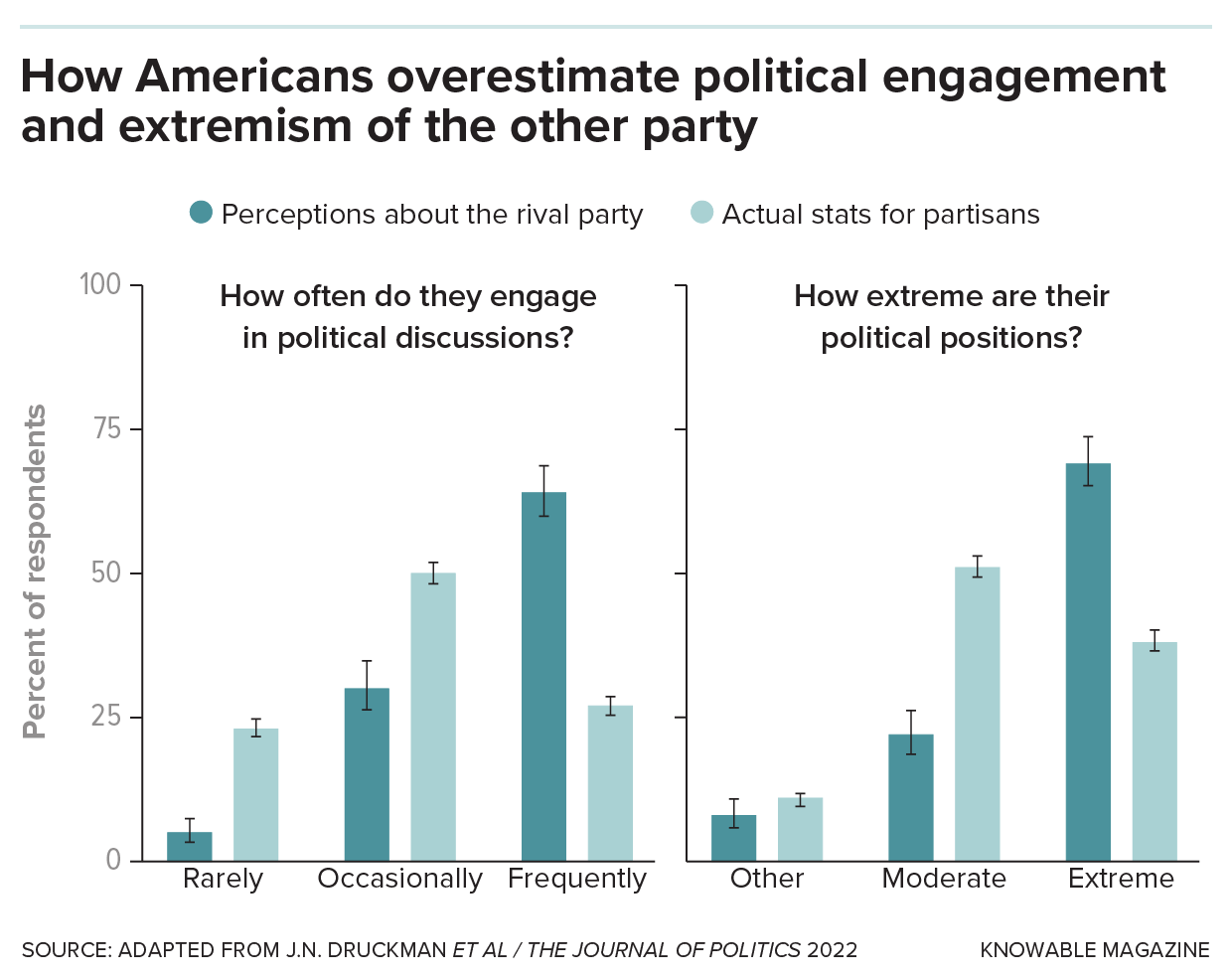
Americans regularly misperceive people with different political loyalties. Participants in this survey reported their perceptions of the “typical” member of the rival party — how ideologically extreme their positions were as well as how frequently they engaged in political discussions. These ratings were then compared with actual behaviors among survey respondents.
The rest of us couldn’t explain the underlying philosophy of our policy positions. Rather, Levendusky says, people look to their party for guidance on what positions they should take, such as being in favor of more stringent gun control and climate policy if you’re a Democrat and being pro-gun rights and anti-tax if you’re a Republican.
In other words, as politicians increasingly prioritized party loyalty over policy deliberation, the electorate followed suit. By the 1990s and early 2000s, the Republican Party had become the camp of white Christian America, while the Democratic Party became a mix of everyone else, Mason says. Geographically, the divide grew: While members of different parties used to meet at church or the grocery store, Democrats increasingly became identified with urban and coastal areas, and Republicans with rural and heartland regions.
As a result, party affiliation evolved beyond political preference and became linked to racial, religious, cultural and geographical identities, Mason and coauthor Julie Wronski wrote in a 2018 paper. This alignment, they noted, intensified loyalty to one’s own party and diminished tolerance for opposing partisans. The growing focus on identity in American politics has been evident in the past decade, reflected in policy priorities, campaign strategies, media coverage and the actions of social movements.
Interestingly, Mason and Wronski’s research suggests — despite what some commentators posit — that Republicans are more susceptible to identity-based politics than those on the left, due to their party’s social homogeneity.
Mason also notes that even when Republicans and Democrats agree on policy, these identities can still foster animosity. To her, rather than carefully weighing the policies of a given party, supporters are becoming just that — supporters. In essence, we’re acting more like fans of a football team going to a game than a banker carefully choosing investments, she says.
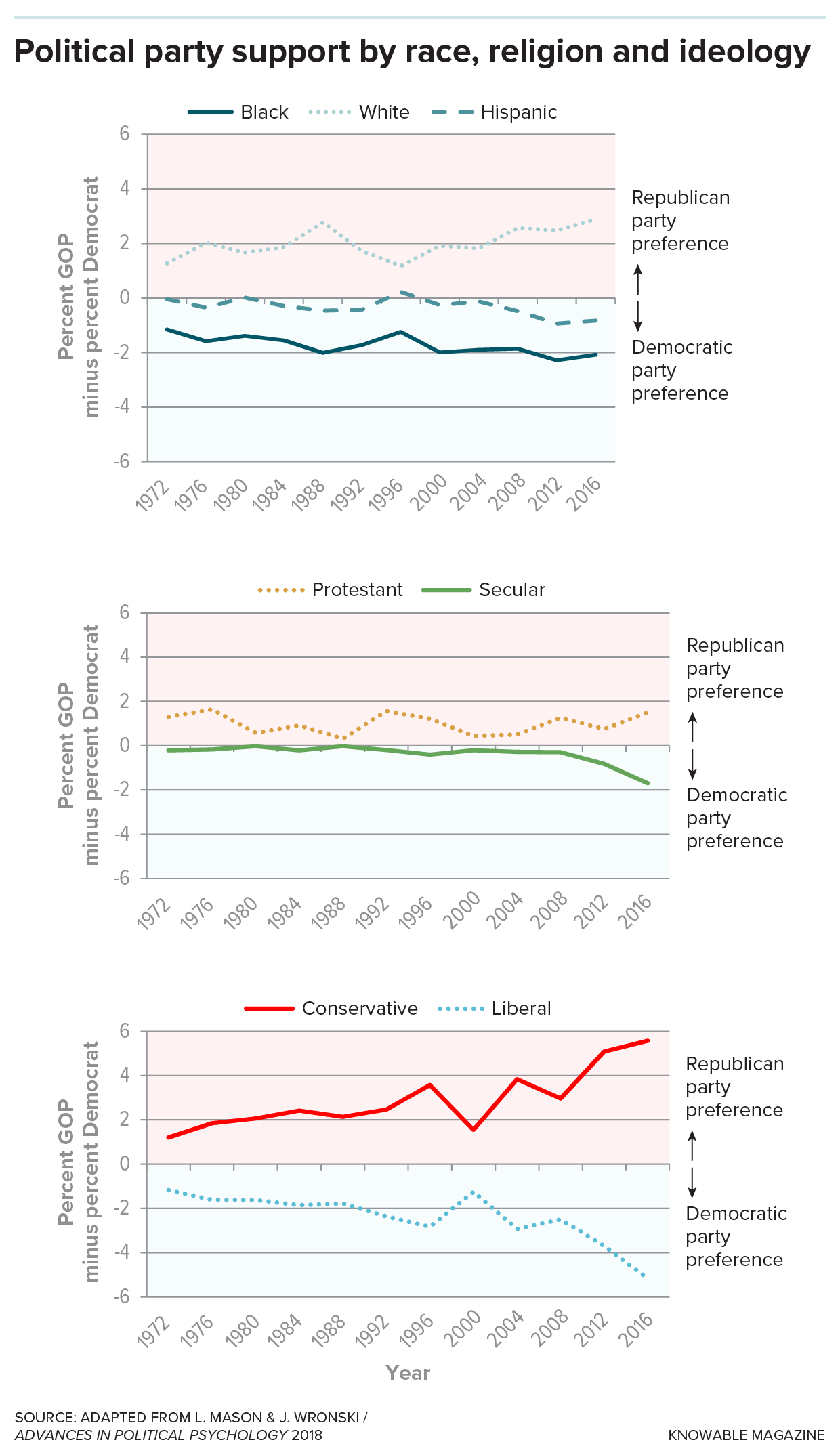
The Democratic and Republican parties have become increasingly distinct in their demographic and ideological compositions. The Democratic Party has seen a growing representation of Blacks, Hispanics, seculars and liberals, shifting from a predominantly white coalition to one characterized by diversity and inclusion of nontraditional groups. In contrast, the Republican Party has solidified its base among whites, Christians and conservatives, reinforcing a homogeneous profile. This clear demographic sorting has led to a widely accepted view of Democrats as champions of racial diversity, religious secularism and liberalism, while Republicans are generally identified as white Christian conservatives.
Taking the political temperature
Other researchers have also concluded that mass polarization in the United States is less about policy-based division and more about people liking their own political camp and disliking the opposing one. A 2019 article in the Annual Review of Political Science, coauthored by Levendusky, shows that such affective polarization has increased drastically in the last four decades. Using survey data from the American National Election Study (ANES), the review measured feelings of warmth or coldness toward one’s own party and the opposing party on a “feeling thermometer” scale from 0 to 100.
Affective polarization, calculated as the difference between these ratings, rose from 22.64 degrees in 1978 to 40.87 degrees in 2016. While warm feelings toward one’s own party remained stable at around 70, sentiment toward the opposing party worsened significantly, dropping from the high 40s to just above 25.
More recent ANES data show that between 2016 and 2020, both warm feelings toward one’s own party and cold feelings toward the opposition increased even further, with affective polarization jumping from 41 to 52.2 degrees.
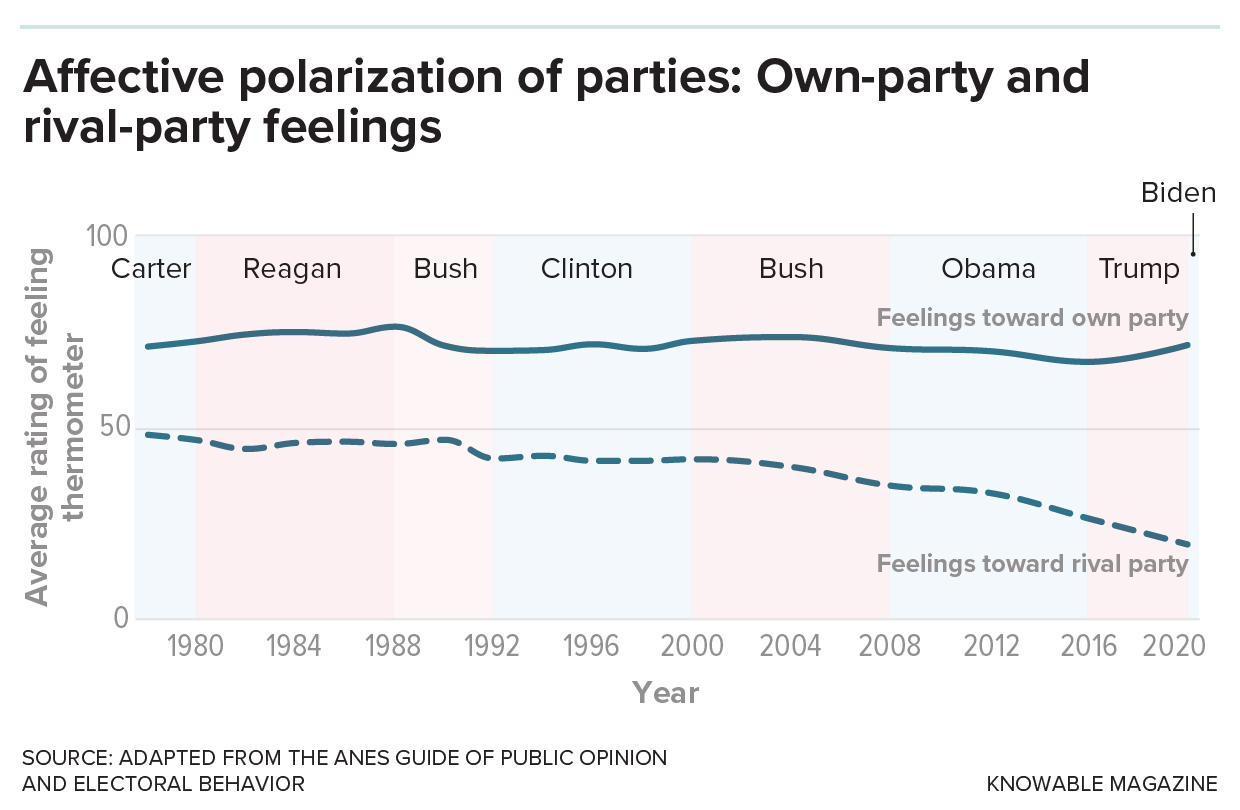
Negative feelings toward the rival party have worsened significantly, while positive feelings toward one’s own party have remained relatively stable. The trend illustrates rising affective polarization, with partisan sentiments becoming increasingly negative toward the opposition.
Researchers have found evidence of a similar dynamic playing out in other countries. For instance, one 2019 study — using the same feelings-thermometer score system — assessed supporters’ feelings toward their preferred and opposing parties in 22 European democracies and the United States between 2005 and 2016. It found that affective polarization was acutely present in European party systems — especially in Central Eastern Europe and Southern Europe.
As in the United States, hatred between voters in Europe isn’t necessarily connected to policy-based division, the study showed. But the link between the two appears to be stronger in structured, Western democracies with clear left-right spectrums, such as Germany and Sweden, notes political scientist Andres Reiljan of the European University Institute near Florence, who authored the study. Conversely, in poorer and less stable countries like Bulgaria and Montenegro, issues such as corruption and perceived incompetence might be more likely to drive hatred than policy divisions, the study suggests.
A 2021 study across 51 countries reported similar results, with countries like Bulgaria, Slovakia and the Czech Republic among the most polarized nations, while Iceland, Finland and the Netherlands appeared significantly less divided. Interestingly, these two studies showed the US as only moderately polarized when compared with other countries, but Reiljan, for one, notes that in his study, the categorization was based on figures from 2016. “Now, with our more recent data, I will say that, yes, it is comparatively also very highly polarized,” he says. “And it’s increasing faster, I would say, than most other countries.”
Reiljan’s suspicion received support from a study measuring trends in 12 OECD countries over the last 40 years. Of the countries included, the US experienced the largest increase in polarization. A 2023 study using the latest available data showed similar results, with the Unites States leading the pack in polarization if measuring the whole electorate, while affective polarization increased most noticeably in the United States and Germany among those who report a partisan identity.
Identity and emotion lead the way
One potential explanation for the intensity of partisan hatred in the US comes from a 2022 study published in the British Journal of Political Science. Examining data from 20 Western democracies since the mid-1990s, it found that people’s anger over political disagreements on issues like migration, religion and LGBTQ+ rights has intensified more than disagreement over economic issues.
These findings hint at what other scholars have proposed in the US context: that polarization today has much to do with identity and emotion. The most central topics in politics, such as abortion rights or racial policy, are essentially identity-based issues, Mason says. “And when the issue is about a group, about their very existence or status, or whether they are respected equally as Americans, or whether they have the same rights as other Americans, it doesn’t feel like an issue for that person. It feels like an existential threat.”
“That change, from debates about the economy to debates about cultural issues, based on our research, has been most dramatic in the United States,” says James Adams, a political scientist at the University of California, Davis, and a coauthor of the British Journal of Political Science study. “That may be one of the reasons why affective polarization has intensified dramatically in the United States over the last 25 years or so.”
Parties across Europe have also homed in on cultural issues, especially populist leaders who leverage explosive topics to rally voter blocs. But while most experts see the rise of extremist parties as a key driver of polarization, studies may fail to fully capture this. Measuring affective polarization in the multiparty context seen in many European countries is challenging because traditional metrics, such as the feeling thermometer, are designed for two-party systems. In multiparty systems, voters may intensely hate one party but feel neutral toward others, diluting the final score.

The US has experienced the most rapid growth in affective polarization among the general electorate since 1980 among the 12 OECD countries considered in this 2024 study, with five other countries experiencing smaller increases in polarization, and six experiencing declines in polarization.
Despite this, there’s a clear polarizing trend to be seen, with these intensely disliked populist parties growing stronger and disliking the mainstream in return, says political scientist Markus Wagner of the University of Vienna, who specializes in research on party competition and political behavior.
Negative campaigns deepen the divide
Research suggests that affective polarization is also fueled by the negative campaigning that has become a staple of modern electoral communication. A 2024 paper analyzing surveys and 17 elections between 2016 and 2020 found that political leaders’ attacks — on opponents’ policies, records or character — exacerbate affective polarization. This effect is more pronounced among those with strong partisan leanings.
Study coauthor Alessandro Nai, who specializes in political communication at the University of Amsterdam, explains that the whole system is part of a toxic spiral, with increased aggressiveness between politicians radicalizing the public, and the public — which is now more radicalized — demanding more aggressiveness from politicians. Nai also has evidence that more extreme, populist followers are more likely to appreciate negative campaign messages, finding them more amusing and fair than moderate citizens do, and are more apt to respond to such messaging with increased affective polarization. People on the populist extremes score higher in traits such as aggressiveness, narcissism and callousness in studies, Nai notes, adding that a “cold” person is therefore more likely to buy the aggressive playbook from politicians.
Importantly, some of Nai’s preliminary research also suggests that negative messaging from one’s own camp stokes more dislike than do attacks from adversaries. In other words, if one’s own preferred politician attacks an adversary, this boosts affective polarization much more than if an adversary attacks your preferred politician.
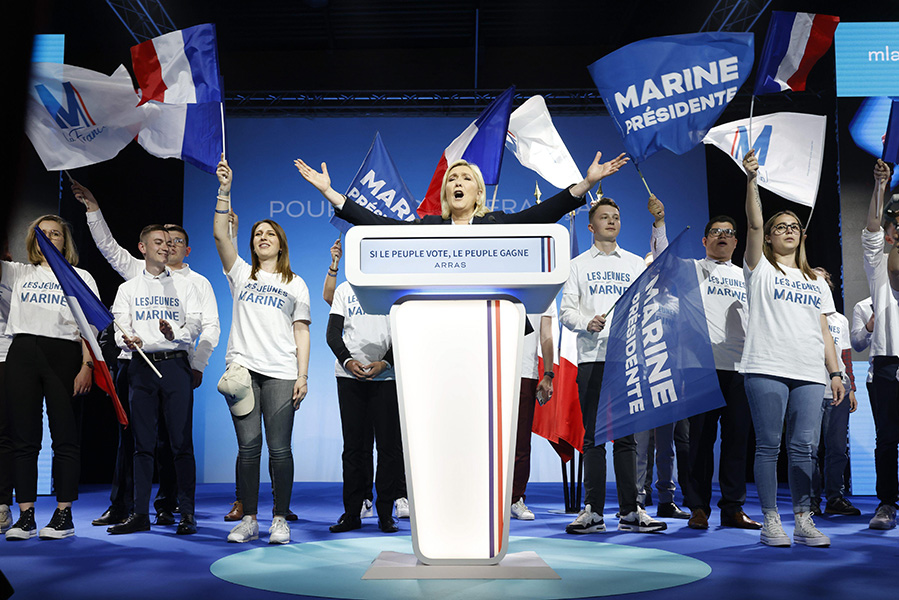
Marine Le Pen, leader of the right-wing National Rally (Rassemblement National), addresses supporters during the 2022 French presidential campaign.
CREDIT: MAXPPP / ALAMY STOCK PHOTO
That might be especially true in today’s siloed, targeted and viral media environment. In their 2022 Journal of Politics paper on how Americans overestimate each other’s political extremeness, Levendusky and coauthors suggest that the caricatured image of “the other side” as extreme ideologues is fueled by social media, where much of the political content is created by people who are disproportionately committed to politics.
As a result, what comes to mind when people think of those from the other party, the study argues, are “fervent partisans pleading their cases,” rather than neighbors or colleagues who rarely discuss politics. The mass media’s focus on political conflict has further enforced this partisan stereotyping.
Simple but effective interventions
The negative impacts of severe polarization are clear. When democratic institutions are viewed as battlegrounds for existential issues rather than arenas for reasoned policymaking, it leaves legislators in gridlocks, judiciaries stacked with loyalists and erodes democratic norms. A crisis of interpersonal trust is added to one of institutional trust: Fellow citizens are reduced to loathed enemies with malicious aims; civility is replaced by hostility as public discourse deteriorates — all while the doorway widens for populist leaders who exploit our emotions by peddling divisive rhetoric and extremist ideologies.
Experts worldwide are now thinking hard behind the scenes about how to pull our societies back from the brink. It’s a mammoth task, especially if considering broader underlying issues. For example, Adams’ research highlights that inequality and unemployment drive affective polarization, and that winner-takes-all electoral systems — such as those in Canada, Britain and the United States — also tend to exacerbate the animosity. These are systemic, structural issues that can’t be solved by focusing on polarization alone. However, researchers have found that some — surprisingly simple — interventions can nonetheless be very effective.
An analysis by a research consortium studying anti-democratic sentiment identified 25 ways to reduce partisan animosity; out of those, three stood out as particularly promising.
One successful intervention involved participants watching a commercial where pairs of individuals with opposing political views formed bonds despite their differences. The video highlighted disagreements on topics like climate change, feminism and transgender identity, yet showed the two people collaborating and ultimately choosing to socialize together. This intervention yielded a 10.47 percent decrease in animosity, based on survey questions conducted before and after the intervention.
In another intervention, participants read book quotes arguing that the news media creates polarization to maximize its audience and that most Democrats and Republicans are part of an “exhausted majority” that rejects polarization. Participants also saw data suggesting that increased consumption of news media correlates with more distorted perceptions of opposing views. Participants were then guided on retaking control from media influence and asked to advise others on achieving this. It resulted in a 10.22 percent decrease in animosity.
A third intervention had participants read about the pivotal role of democracy in America’s leadership in technology and culture, and how extreme partisanship threatens this. They learned that research shows that the vast majority of Americans support democracy and that, contrary to popular belief, most members of both parties support democratic rules, disapprove of violence, and like one another. Participants were then asked to write about their two favorite things about being American. The intervention resulted in a 9.20 percent decrease in animosity.
By appealing to people’s sense of camaraderie, common nationality and resistance to exploitative media, these simple methods proved capable of reducing partisan animosity, at least in study settings. In her 2022 book on American partisanship, Mason similarly notes how minimal interventions can have significant impacts. “We found that just reading a quote from either Joe Biden or Donald Trump that says violence is not OK makes people less approving of violence,” she says.
Adams emphasizes the need to dial down the aggressive rhetoric among leaders, where Democrats and Republicans publicly demonize the other side. He references a working paper on the 2022 US elections that found a reduction in Twitter toxicity with this unusual method: Researchers informed politicians that they were monitoring their accounts and that their tweet toxicity scores would be sent to a non-governmental organization for possible publication just before the election.
Another effective method, Adams says, might be demonstrating to politicians that toxic rhetoric doesn’t necessarily benefit them. An additional working paper found that although politicians who frequently use insults gain more media attention, they generally perform worse than politicians who focus on policy: They’re assigned to less powerful committees, don’t perform better in elections and don’t raise more campaign funds.
Researchers are only starting to understand the prevalence and drivers of polarization around the world. And while there is no silver bullet to close the yawning social and political gaps dividing our societies, it’s a hopeful sign that the issue has now entered the public consciousness. Only five years ago, Adams says, few academic journals paid any mind to research about affective polarization. “I think a lot of political scientists just thought, ‘Well, it’s only about people’s feelings,’” he says. Then came January 6 and the storming of the US Capitol. “Suddenly, now, everyone is interested in affective polarization.”
Reiljan tells a similar story — that when he started his research as a PhD student in 2015, there was barely any cross-country scholarship on the topic available. Some months back, he hosted a conference on polarization where scholars from across Europe and North America gathered to brainstorm strategies to reduce it.
10.1146/knowable-081924-1
TAKE A DEEPER DIVE | Explore Related Scholarly Articles





